
231 Australian Cinema 2008
Social realism
This week's readings | Australasian social realist films
Clips
Shame (Steve Jodrell, 1988)
Yolngu Boy (Stephen Johnson, 2001)
Teesh and Trude (Melanie Rodriga, 2002)
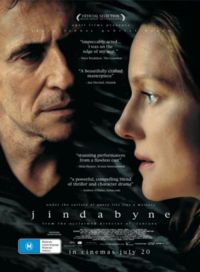
Rabbit-Proof Fence (Phil Noyce, 2001)
Romper Stomper (Geoffrey Wright, 1992)
Angel Baby (Michael Rymer, 1995)
Blackrock (Steven Vidler, 1997)
Main screening
Jindabyne (Ray Lawrence, 2006) 125 min.
See also: Coming-of-age/rite of passage, Melodrama
This type of film is described - not so much by film theorists or critics - as by social agencies such as sociology, psychology, criminology. It's defined not by its aesthetic or narrative form but by its content.
In this presentation I want to illustrate these points.
-
Social problem films form a genre (type) which is suitable for Oz conditions of production.
-
Social problem films reveal an idiosyncratically Australian character; and the social problems in films of this type differ somewhat from their American precursors, as to be expected with cultural differences.
-
Following from 2., some American social problem film issues are not significant in Australia (capital punishment), while others (especially racism) are prevalent.
-
Which social problems are dealt with in films changes over time.
Marcia Landy defines a "social problem film" as one which is
directed toward the dramatization of topical social issues - capital punishment, prison life, juvenile delinquency, poverty, marital conflict, family tension, and, to a lesser degree, racism. [footnote 1]
To her list I want to add the treatment of madness as a social problem, especially in relation to institutionalisation. We'll see this in the clip from Angel Baby (Michael Rymer, 1995), but there are other films in which this is important, especially Lilian's Story (Jerzy Domaradzki, 1996) and Cosi (Mark Joffe, 1996).
Another possibility is the bikie film: its parent is The Wild One (Laslo Benedek, 1954), with Marlon Brando (as Johnny) as the leader of the pack. Australian relatives include Stone (Sandy Harbutt, 1974), Mad Max (Dr George Miller, 1979), and the variationary Shame (Steve Jodrell, 1988). Related to this type are petrol-head films like Running on Empty (John Clark, 1982) and Metal Skin (Geoffrey Wright, 1995).
Put more generally, a problem film
combines social analysis and dramatic conflict within a coherent narrative structure. Social content is transformed into dramatic events and movie narrative adapted to accommodate social issues as story material through a particular set of movie conventions. [footnote 2]
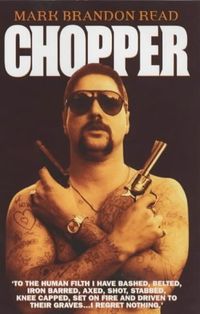
capital punishment
... no examples [footnote 3]
prison life
... no examples
The scene in Pentridge Prison at the beginning of Chopper (screened in the biopic week) will have to suffice: it's enough, surely. [footnote 4]
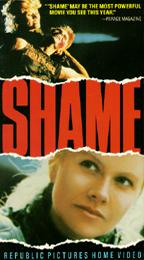
juvenile delinquency
I'm glad that Albert Moran has headlined women heroes and especially the one in Shame (Steve Jodrell, 1988), as it is one of the best of the handful of feature films made in Western Australia and was directed by someone I used to know personally when we were 'at uni' at the same time. [footnote 6] It's just a pity Moran spells wrongly the name of the heroine (oh sorry, not allowed to use that word, even tho we have to replace it with two). However, I'm told that Albert is virtually blind now, so I suppose he can't do his own proof-reading. Shame is a bit of road movie - Asta rides into town on a motorbike - a bit of a western - the loner rides into town, cleans it up, and leaves - and a bit of a woman's film - with a powerful central female character. The masculinist culture of the small town (the film was shot in Toodyay) includes a tolerance of rape, so Asta has to take on the rapists. At the time of writing, the film has not been re-released on DVD, so the clip you'll see has been copied to digital from videotape. You might know the lead actor, Deborra-Lee Furness, better as Mrs Hugh Jackman. She also appears in Jindabyne (Ray Lawrence, 2006). [clip "attack" 28.15 - 31.45)
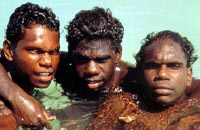 Yolngu Boy (Stephen Johnson, 2001)
Yolngu Boy (Stephen Johnson, 2001)
This film proposes a dichotomy between the temptations of the white world of walkmans and petrol and the traditional world of ceremony and totemic meaningfulness. Botj is the one character out of the three main boys who falls by the white wayside: near the end of the film he dies (spoiler, sorry). Unfortunately, the actor who plays Botj (Sean Mununggurr) was/is in real life a petrol-sniffer. [footnote 5 ] In this scene Botj steals petrol to sniff, trashes the community centre and burns his arm. You'll also see flashbacks to an initiation ceremony. [clip "petrol" 15.38 - 19.56]

anti-social behaviour
Running on Empty (John Clark, 1982)
I showed this scene in the road movie week in 2008. The petrol heads in this film are not juveniles, but do not show much maturity in believing that to lose one's car is equivalent to losing one's life. In the final scene, Fox (Richard Moir) has lost his car by losing a race. Will he give it up to Mike (Terry Serio)? [clip "ending" 1.19.47 - 1.21.03]
Stone (Sandy Harbutt, 1974)
I can't show a clip from this bikie film, as the full-price copy I bought appears to have no data on it. I can't remember which of my many suppliers I bought it from, so I'll have to buy another one, I guess.
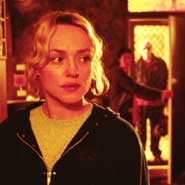
poverty/marital conflict/family tension
Teesh and Trude (Melanie Rodriga, 2002)
Teesh (Susie Porter) has given Kenny half a sleeping tablet, and her jailbird father Bob (Bill McCluskey) discovers this and threatens to take the child away, in order to get control of the situation. He threatens both women. When he leaves to go and get more beer, Teesh tells Trude (Linda Cropper): "If it wasn't for that fuckin TV, I wouldn't know what day it was." Note the mise-en-scene - that set was constructed only a hundred metres from where you are right now (if you're reading this in BHLT, in EH at MU). [clip "threat" 34.38 - 38.27]

racism
Rabbit-Proof Fence (Phil Noyce, 2001)
After the scene after the one in which the children are taken away from their mothers, Mr Neville (aka "Mr Devil"), played by Kenneth Branagh, shows why the half-castes have to be taken away. [clip "stolen" 10.56 - 14.00]
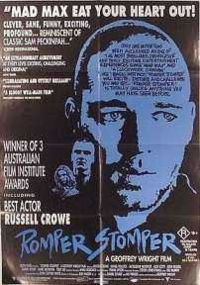 Romper Stomper (Geoffrey Wright, 1992)
Romper Stomper (Geoffrey Wright, 1992)
At the beginning of the film the neo-Nazi gang leader Hando (Russell Crowe) tells a Viet boy, "This is not your country."[clip "skaters" 00.52 - 3.00]

madness as a social problem
Angel Baby (Michael Rymer, 1995)
In this scene, at the beginning of the second act, Kate and John discuss her pregnancy with the medical profession and his family. Because they have been diagnosed as schizophrenic, there is great opposition to them proceeding. [clip "shrink" 38.10 - 41.42]

violence directed at women
Blackrock (Steven Vidler, 1997)
This is loosely based on the true story of the sexual assault and murder of a girl called Leigh Leigh on a beach at Newcastle NSW. The film intercuts between scenes of the young people and their parents to suggest that the latter are not necessarily very good role models.[clip "rape" 20.57 - 23.46]
other films considered but not shown
The Boys (Rowan Woods, 1997) ... culture of rape
Fran (Glenda Hambly, 1985) ... like Mallboy and Teesh and Trude
Jenny Kissed Me (Brian Trenchard-Smith, 1986) ... melodrama
Lilian's Story (Jerzy Domaradzki, 1996) ... incest, cf. Angel Baby
bikie culture
Mad Max ([Dr] George Miller, 1979)
Shame (Steve Jodrell, 1988) [footnote 6 ] ... culture of rape
Footnotes
1. Marcia Landy 1991, British Genres: Hollywood and Society 1930-1960, Princeton University Press, Princeton: 432, as cited in Steve Neale 2000, Genre and Hollywood, Routledge, London & New York: 113.
2. P. Roffman & J. Purdy 1981, The Hollywod Social Problem Film: Madness, Despair and Politics from the Depression to the Fifties, Indiana University Press, Bloomington: viii, as quoted in Steve Neale 2000: 113.
3. This is not an issue in Australia (in the execution, as it were) as capital punishment is not currently on the books in any state. Cf. Dead Man Walking (Tim Robbins, 1995), among the many stateside films dealing with this live (as it were) issue.
4. Other Oz films which deal specifically with the experience of being in prison (and you don't want to see them) include:
Every Night ... Every Night (Alkinos Tsilimidos, 1994)
Ghosts ... of the Civil Dead (John Hillcoat, 1989)
Stir! (Stephen Wallace, 1980)
27A (Esben Storm, 1974).
No Escape [Escape from Absolom] (Martin Campbell, 1994) and
Turkey Shoot (Brian Trenchard-Smith, 1982) are set in fantasy prisons, in "the future".
Both Dead Heart (Nicholas Parsons, 1996) and
Deadly (Esben Storm, 1992) are partly concerned with Aboriginal deaths in custody.
5. "Sean was a bad petrol sniffer before I met him and he was on petrol the day I screen-tested him," Mr Johnson said. "For the 12 months he worked on the film, he wasn't sniffing. We made sure there was a six-week wind-down period to get the three kids back into community life after filming. But Sean is a wild child." Paul Toohey, "A cult of immortality in the fumes", The Australian, 29 June 2001, pp. 1, 3.
6. Of especial interest for Western Australians: shot in and around Toodyay.
One of the few feature films made in WA.
New: 18 March, 2004 | Now:
28 April, 2022










